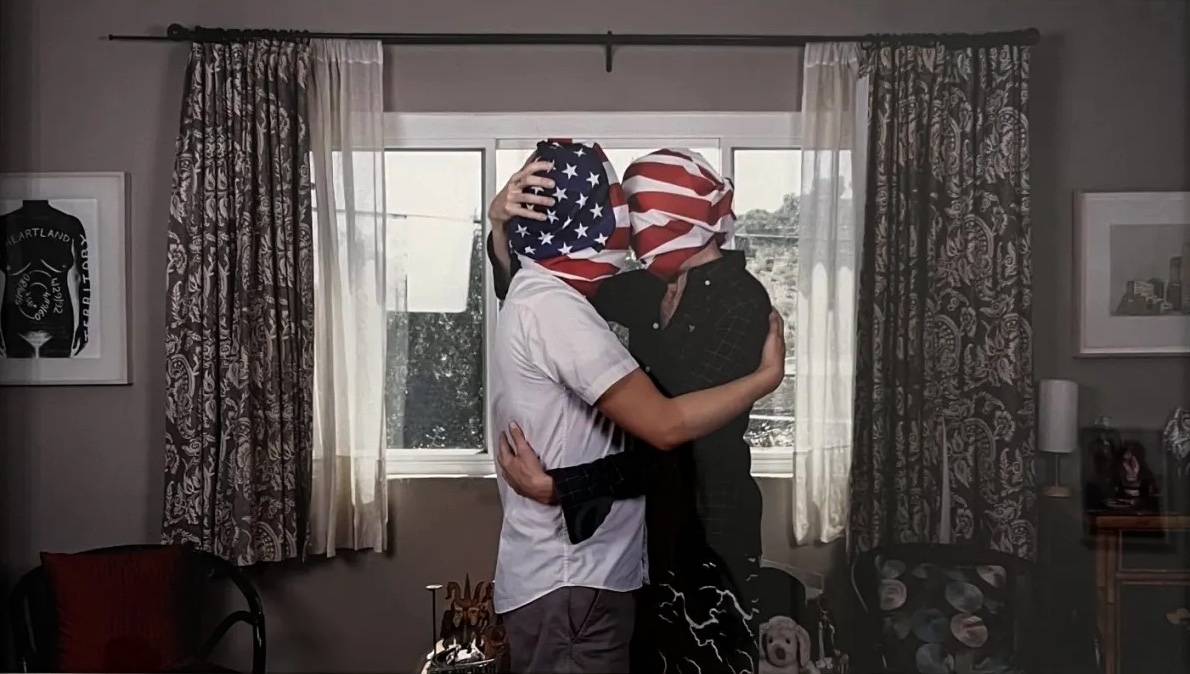IRVINE, California — The work of late artist Yong Soon Min upholds her legacy through its continued relevance in an age of ongoing geopolitical instability. KISSSSS, on view at the Contemporary Arts Center Gallery at the University of California Irvine through December 14, showcases Min’s lifelong commitment to considering the relationship between the unremitting Korean War and her diasporic identity, including the final works she created before she passed.
In the late 1990s, Yong Soon Min traveled to Panmunjom’s Joint Security Area within the Korean Demilitarized Zone (DMZ) and purchased two postcard bundles — one from South Korea in 1995 and one from North Korea in 1998. For the print work “Both Sides Now” (2018), Min spliced together five postcards from each set, revealing parallel views from both sides’ perspectives. Min reminds us that the political is personal; as art historian Kim Hong-Hee writes in Korean Feminist Artists: Confront and Deconstruct, “This is the DMZ, which is analogous to the artist’s own situation: looking on from the edge with a dual identity that is neither fully American nor fully Korean.”
Panmunjom also takes center stage in “Still/Incessant” (2018/24), an artist’s book displayed on a table adjacent to “Both Sides Now.” An image of three military-green tables inside the village’s Peace Museum, which bore witness to the signing of the Korean Armistice Agreement that established a ceasefire between North and South Korea, is featured as a full spread on every page. As we flip the pages, the image iteratively becomes more saturated in red by an increment of 1% until the final images are entirely washed out.
Min’s final, unfinished work, “KISSSSS” (2024), occupies the gallery’s long corridor and culminates in a larger-than-life-sized print of the same image of the three tables. Seven brick “stations” dot the space’s length, marking critical historical moments throughout the Korean War. These begin in 1945, at the end of World War II and Japanese Imperial rule, and the beginning of construction for the 38th parallel that divides North and South Korea. The final station spans June 27, 1953 to the present, marking the signing of the Armistice Agreement. Min’s notes read, “The Koreans are technically still at war today,” emphasizing the war as an ongoing conflict with a larger geopolitical context rather than an isolated event.
Seven photographs correspond with the stations, featuring actors in various states of embrace with flags obscuring their faces. The motif references René Magritte’s 1928 painting “The Lovers,” perhaps pointing to overlaps in unfulfilled desires for unification. These intimate images highlight the complicated entanglements between the United States, the United Nations, South Korea, North Korea, the Soviet Union, and China.
Min’s transnational perspective applies to feminist activists currently working to establish peace across the DMZ. On October 30, the government prohibited prominent Korean-American activist Christine Ahn from entering South Korea, barring her from delivering a keynote address at the International Youth Peace Forum in Gyeonggi Province. This event points to the degradation of civil society at the hands of South Korea’s increasingly anti-democratic government, speaking to a broader history of gender-based violence and political exclusion during times of conflict. These symptoms of ongoing militarization run seven generations deep, outlining conditions of a “new Cold War” that isn’t new at all.


Yong Soon Min: KISSSSS continues at the Contemporary Arts Center Gallery at the University of California Irvine (4000 Mesa Road, Irvine, California) through December 14. The exhibition was organized by Bridget R. Cooks.

